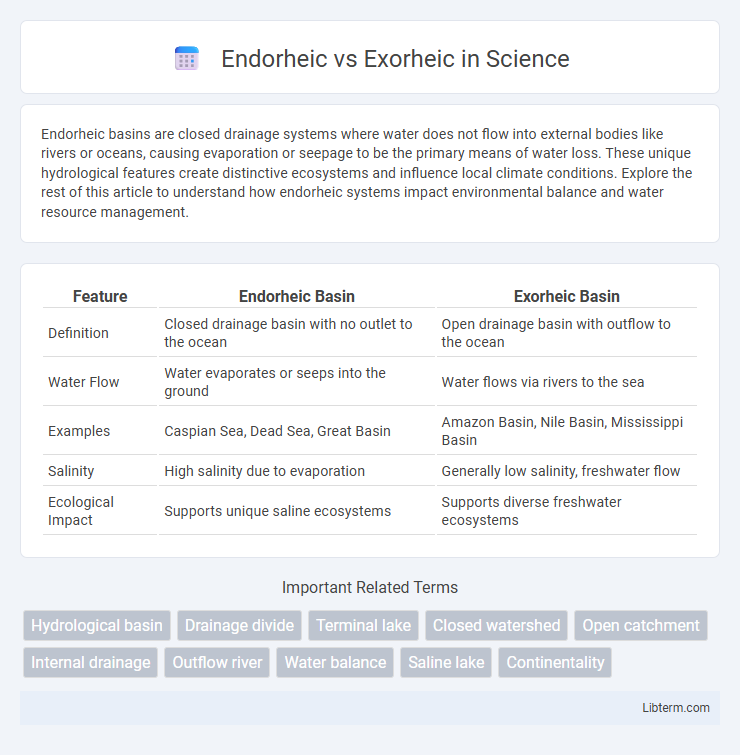Endorheic basins are closed drainage systems where water does not flow into external bodies like rivers or oceans, causing evaporation or seepage to be the primary means of water loss. These unique hydrological features create distinctive ecosystems and influence local climate conditions. Explore the rest of this article to understand how endorheic systems impact environmental balance and water resource management.
Table of Comparison
| Feature | Endorheic Basin | Exorheic Basin |
|---|---|---|
| Definition | Closed drainage basin with no outlet to the ocean | Open drainage basin with outflow to the ocean |
| Water Flow | Water evaporates or seeps into the ground | Water flows via rivers to the sea |
| Examples | Caspian Sea, Dead Sea, Great Basin | Amazon Basin, Nile Basin, Mississippi Basin |
| Salinity | High salinity due to evaporation | Generally low salinity, freshwater flow |
| Ecological Impact | Supports unique saline ecosystems | Supports diverse freshwater ecosystems |
Introduction to Endorheic and Exorheic Systems
Endorheic systems are closed drainage basins where water does not flow out to the ocean, often resulting in lakes or wetlands with high salinity due to evaporation. Exorheic systems contrast by having open drainage basins with rivers or streams that discharge into the ocean or large lakes, maintaining a continuous flow. Understanding the distinction between endorheic and exorheic basins is crucial for hydrology, ecology, and water resource management.
Defining Endorheic Basins
Endorheic basins are closed drainage systems where water does not flow out to the ocean but converges into lakes or swamps, often resulting in high salinity due to evaporation. These basins retain precipitation locally, leading to unique ecosystems and distinct hydrological characteristics compared to exorheic basins that drain into external bodies of water. Prominent examples of endorheic basins include the Caspian Sea, the Great Salt Lake, and the Aral Sea, highlighting their global geographical significance.
Understanding Exorheic Drainage
Exorheic drainage systems discharge water into the ocean, sea, or external basins, enabling continuous flow and sediment transport. These basins typically feature defined river networks that facilitate drainage beyond the continental boundaries, supporting diverse ecosystems and human settlements. Understanding exorheic drainage is crucial for water resource management, flood control, and environmental conservation in regions with outward-flowing rivers.
Key Differences Between Endorheic and Exorheic Systems
Endorheic systems are closed drainage basins where water does not flow out to the ocean but evaporates or seeps into the ground, exemplified by the Caspian Sea basin. Exorheic systems feature open drainage basins with rivers or streams that ultimately discharge into the ocean, such as the Mississippi River basin. Key differences include water flow patterns, ecosystem dynamics, and sediment transport, with endorheic basins often hosting hypersaline lakes and unique biota due to their isolated water cycling.
Geographic Distribution of Endorheic Basins
Endorheic basins primarily occur in arid and semi-arid regions such as Central Asia's Caspian Sea or Africa's Lake Chad, where the lack of outlet rivers causes water to accumulate and evaporate rather than draining into oceans. These basins are common in continental interiors and desert landscapes, exemplified by the Great Basin in the western United States. Their geographic distribution reflects climatic factors that limit outflow, resulting in closed drainage systems that significantly affect local hydrology and ecology.
Major Exorheic Rivers and Their Pathways
Major exorheic rivers, such as the Nile, Amazon, and Mississippi, flow outward to the ocean, forming crucial drainage systems that support vast ecosystems and human civilizations. These rivers facilitate nutrient transport, sediment deposition, and freshwater supply over extensive continental areas, shaping fertile deltas and coastal environments. Their continuous pathways from source to sea contrast sharply with endorheic basins, where water is trapped, evaporating or seeping without reaching the ocean.
Environmental Impacts of Endorheic vs Exorheic Watersheds
Endorheic watersheds, characterized by closed basins where water does not flow to the ocean, often lead to high salinity levels and accumulation of pollutants, negatively impacting aquatic ecosystems and surrounding soil quality. Exorheic watersheds, with open drainage systems flowing into oceans or seas, facilitate the natural dilution and transport of nutrients and contaminants, promoting healthier downstream environments. The restricted outflow in endorheic basins increases vulnerability to water scarcity and habitat degradation compared to the more dynamic and renewable water cycles in exorheic systems.
Hydrological Processes in Endorheic Systems
Endorheic systems are characterized by closed drainage basins where water does not flow to external bodies like oceans but accumulates in inland lakes or evaporates, leading to high salinity and mineral concentration. Hydrological processes in these basins involve limited outflow, with evaporation exceeding precipitation, resulting in significant water balance and solute transport dynamics unique to arid and semi-arid environments. Unlike exorheic systems which feature open drainage with rivers discharging into seas, endorheic basins sustain internal water cycles that influence groundwater recharge, sediment deposition, and ecological habitats.
Human Activities and Their Effects on Drainage Patterns
Human activities such as urbanization and agriculture significantly alter drainage patterns in endorheic basins by increasing surface runoff and reducing natural water infiltration, leading to heightened soil salinity and water scarcity. In exorheic systems, dam construction and river channelization disrupt sediment transport and flow regimes, impacting aquatic ecosystems and downstream water availability. These modifications often exacerbate flood risks in endorheic basins and reduce sediment deposition in coastal areas for exorheic basins, influencing regional hydrology and environmental stability.
Conclusion: Importance of Understanding Drainage Systems
Understanding the distinction between endorheic and exorheic drainage systems is crucial for effective water resource management and environmental planning. Endorheic basins, which retain water and prevent outflow to external bodies, influence local climate and ecosystem stability, whereas exorheic systems facilitate water flow to oceans, impacting sediment transport and nutrient cycling. Proper knowledge of these drainage types supports sustainable development, flood control, and conservation strategies tailored to regional hydrological characteristics.
Endorheic Infographic

 libterm.com
libterm.com